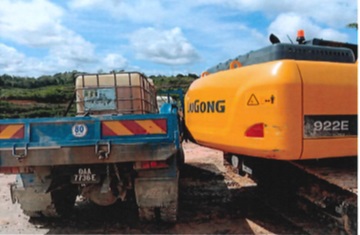Vehicle Safety in Construction Site
Introduction
1. Accidents involving vehicles in construction site occur recently and every year. In 2019, 27 workers were killed in vehicle-related accidents in construction sites. Twelve of them were general workers, whilst five were

Figure 1. In 2019, vehicle-related accidents contributed the second highest number of construction workers fatality.
2. The leading causes of death are workers being crushed or struck by vehicles or falling off them. The primary type of vehicle involved in fatal accidents was lorry (8).
3. This guidance is aimed at managers and drivers to help them reduce the probability of vehicle-related accidents happening. Employers have a legal duty to ensure that the safety and health of their employees, contractors and members of the public are not put at risk as a result of their undertaking.
4. Employees and the self-employed person have a duty to look after their own safety and health and that of other persons who might be affected by their work.
5. Vehicle safety includes vehicles used in a site, as well as vehicle, is being parked on a public road adjacent to a site for loading and unloading.
Managing vehicle safety in construction site
6. Safety management of vehicle requires risk assessments. The risk assessment should consider three key areas, namely:
-
safe site (design and activity);
-
safe vehicle; and
-
safe driver.
Safe site - design
Segregation
-
Provide separate worker and vehicle traffic routes
-
In case complete segregation is not possible, clearly mark worker and vehicle traffic routes, using barriers and signs
-
Provide separate entrances and exits for workers and vehicles
Traffic routes, including temporary traffic routes
-
Ensure routes are wide enough for safe manoeuvre of vehicles
-
Ensure routes surfaces are suitable for the workers and vehicles
-
If possible, use a one-way system to reduce vehicle reversing
-
Avoid steep slopes
-
Avoid sharp corners and blind bends
-
Keep routes clear of obstructions
-
Properly maintain the routes
Visibility
-
Provide adequate visibility to enable drivers to see hazards, and workers to see vehicles
-
Install mirrors at sharp corners and blind bends
Speed
-
Enforce appropriate speed limits.
-
For example, lower speed limits where workers are present or the route is shared with other vehicles
Signs, signals and markings
-
Use the same signs as those used on public roads
-
Put signs in proper positions and keep them clean
-
If it is required to drive in the dark, use illuminated or reflective signs
Lighting
-
Provide suitable and sufficient lighting, especially where workers and vehicles cross, and loading/ unloading is carried out
Safe site - activity
Reversing
-
Clearly mark designated reversing areas
-
Install equipment on vehicles to help driver and workers, for example reversing alarms, flashing beacons and proximity-sensing devices
Signalling
-
Appoint flagman to guide drivers especially during reversing
Parking
-
Provide designated areas for vehicle's loading and unloading
-
Drivers must ensure vehicle's brake is applied, the engine is off, and the key to the vehicle has been removed
Loading and unloading
-
Provide information on the nature of the load and how it should be properly loaded, secured and unloaded
-
Provide loading and unloading areas that are clear of traffic and workers not involved in the activity
-
Carry out on the level ground and clear of overhead cables or pipes
-
Make sure drivers are always in a safe place during loading and unloading

Figure 2. Lorry driver is usually exposed to vehicle-related hazards.
Tipping
-
Make sure tipping is carried out on ground level
-
Use wheel stopper
-
Ensure no workers are in the tipping area
Overturning
-
Use a suitable vehicle
-
Consider limiting the operating speed of the vehicle according to the surface, slope and nature of the routes
Shared premises
-
Employers, employees and the self-employed person who share a construction site should cooperate and communicate with each other
-
The main contractor should take responsibility for coordinating any safety and health measures
Safe vehicle
-
Use vehicles that are suitable for the purpose, by considering the working environment
-
Install warning devices
-
Ensure drivers are able to see clearly around their vehicle
Maintenance
-
Maintain vehicle in good working order to ensure it remains mechanically sound, and any devices function properly
-
Conduct regular maintenance inspections
-
Provide daily checks for drivers
Safe driver
Competence
-
Ensure drivers receive the appropriate information, instruction and training for the vehicle they use
Fitness to operate
-
Ensure drivers are fit to drive. For example, refer to http://www.myhealth.gov.my/ for suitable level of vision for driving
References
-
Workplace transport safety: A brief guide INDG199(rev2). www.hse.gov.uk/pubns/indg199.htm.
-
Guidelines on Occupational Safety and Health in Construction Industry (Excavation Work) 2017